CHUNGA'S REVENGE: MAINSTREAM POP
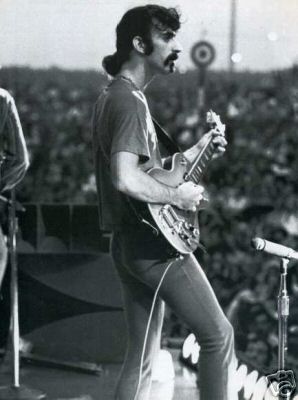 Incidentally Zappa met the former singing duo of The Turtles,
Mark Volman and Howard Kaylan. They had visited the Zappa concert in the L.A. Pauley Pavilion with Zubin
Metha conducting the L.A. Philharmonic. They were in legal conflicts with their manager and other band members and in a
difficult working position. The contracts ruled out that they could perform as The Turtles; they even weren't
allowed to use their own names as name for a duo. Zappa offered them an opportunity to work with him and
they chose to call themselves the Phlorescent Leech and Eddie, mostly shortened up as Flo and Eddie.
They made their first appearance on "Chunga's Revenge" (1970).
Incidentally Zappa met the former singing duo of The Turtles,
Mark Volman and Howard Kaylan. They had visited the Zappa concert in the L.A. Pauley Pavilion with Zubin
Metha conducting the L.A. Philharmonic. They were in legal conflicts with their manager and other band members and in a
difficult working position. The contracts ruled out that they could perform as The Turtles; they even weren't
allowed to use their own names as name for a duo. Zappa offered them an opportunity to work with him and
they chose to call themselves the Phlorescent Leech and Eddie, mostly shortened up as Flo and Eddie.
They made their first appearance on "Chunga's Revenge" (1970).
In 1970 Zappa was busy forming the second line up of the Mothers of Invention and
restarted touring. To give this band some new material of its own, "Chunga's
Revenge" was released with a mixture of studio and live music. The album contains
some more accessible material with for instance a traditional blues piece "Road ladies", the
relaxed "Sharleena" and a riff-based song called "Tell me you love".
Right: FZ, ca. 1970 (source unknown).
1. Transylvania boogie
Originally "Transylvania boogie" was a composed instrumental instead of the largely improvised version of this song
on "Chunga's revenge". Here Zappa is using various scales, among others gypsy
type ones (as already noticed at www.zappateers.com by member "Mosschops"). The gypsy scale exists in a few variants, that have
in common that they include one or two augmented seconds. It still has seven notes in it, as a diatonic scale,
thus this augmented second gets compensated by extra minor seconds. Another feature of the "Ahead of their time" version
is that it's using two meters simultaneously all through. The rhythm section plays in 3/4, while the lead melody is
either in 4/4 or in 8/4.
On "Ahead of their time" you hear the band playing three themes, harmonized in various ways:
- Theme I: pick-up bar and bars 1-2 of the first transcription. This theme is played in two variants, each lasting 8/4.
When it returns after theme III has ended, it gets played at double speed. The bass is using an A as pedal note for most of this song, but
here also turns to E. Over this A by the bass you see the following scales being used:
a) A-Bb-C#-D-E-F-G (the F is present in the preceding bars).
b) C#-D-E-F-G-A-B.
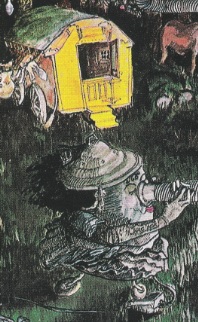 Because of the ongoing D chord and a secondary E in the bass line, the A of the bass at this point loses much of its function as a tonic for the whole.
The first scale is a gypsy type one with an augmented second (Bb-C#), the second is a self-created one. It's thus
likely that this reference to the gypsy scale is also responsible for the title of the song and the gypsy scene
on the inside album cover by Cal Schenkel (outtake to the right). Transylvania is a region in Eastern Europe and most European gypsies live in Eastern Europe. The vacuum
cleaner from the album cover returns in "200 Motels" and the 1970 VPRO documentary, where it's shown
how it can be used for "stimulating pies" (televised on Dutch TV).
Because of the ongoing D chord and a secondary E in the bass line, the A of the bass at this point loses much of its function as a tonic for the whole.
The first scale is a gypsy type one with an augmented second (Bb-C#), the second is a self-created one. It's thus
likely that this reference to the gypsy scale is also responsible for the title of the song and the gypsy scene
on the inside album cover by Cal Schenkel (outtake to the right). Transylvania is a region in Eastern Europe and most European gypsies live in Eastern Europe. The vacuum
cleaner from the album cover returns in "200 Motels" and the 1970 VPRO documentary, where it's shown
how it can be used for "stimulating pies" (televised on Dutch TV).
- Theme II: bars 3-8. A shorter theme in 4/4, also played in two variants. Here Zappa is applying normal A Mixolydian with the bass
setting the A as tonic, as usual:
c) A-B-C#-D-E-F#-G.
- Theme III; bars 8-16. Another theme lasting 8/4. At first it's played following a second gypsy type of scale:
d) C#-D-E-F-G-Ab-B.
Here the augmented second happens with Ab-B. The bass continues with A natural, thus it's getting a bit chromatic here.
A lot more so when this theme gets harmonized. Then it's thus chromatic that you can't relate this version of the theme to a
certain scale anymore.
Transylvania boogie (Ahead of their time), themes (midi file).
Transylvania boogie (Chunga's revenge), opening (midi file).
Transylvania boogie (Ahead of their time), themes (transcription).
Transylvania boogie (Chunga's revenge), opening (transcription).
On "Chunga's revenge" this song has become the album opener. It's mostly an improvised variation upon the "Ahead of their
time" track. The transcription contains the opening bars. The general construction of this song on "Chunga's revenge" goes as:
- 0:00 First block beginning with a variations upon theme I from above in bars 1-4, also beginning with a A-Bb-C# movement.
Next Zappa continues to improvise in this gypsy type key.
In bar 9 the G gets altered to G# and in bar 11 the D becomes D#. By adding these chromatic ingredients, it's becoming an even more exotic type
of scale. In bar 13 Zappa turns over to A Mixolydian with bass and keyboard forming the I chord. It can also be interpreted as E Dorian because
the weight of the bass line here lies on E. During most of the song it's A pedal. The D and G become natural again in bars 15 and 17. The F# from the
A Mixolydian scale only first turns up
at 0:41, not included in the transcription from above. Other than on "Ahead of their time" the band is playing in 4/4 for
the larger part of the song.
- 1:57 Second block with theme II returning mostly identically.
- 2:05 Third block with theme III with extensions.
- 2:38 Fourth block with Zappa continuing to solo in A Mixolydian.
- 5:01 End.
In 2023 the ZFT released "Funky nothingness", showing this title got recorded during the Record Plant sessions from March 1970. In total
this title lasted 18 minutes, of which only the last five minutes landed on the "Chunga's revenge" album. On "Funky nothingness"
this composition starts as how the band played it on "Ahead of their time".
2. Road ladies
"Road ladies" is a blues-based song. In the album liner notes Zappa calls all lyrics from "Chunga's revenge" a preview
of the story from "200 Motels". Only "Road ladies" is directly related to the eventual "200 Motels" movie. Since not all scenes could be
filmed, it's possible that other titles from "Chunga's revenge" are related to the movie script as well. See below at track 6 for an example that at least
the idea once existed for including titles from "Chunga's revenge" into the film.
It's certain that this applies to songs from the next "Fillmore East" album, but these didn't make it to the movie neither.
Road ladies, guitar solo (midi file).
Road ladies, guitar solo (transcription).
The example above is the guitar solo from this song, following the 12-bars blues pattern. It can be heard between 2:07-2:46 (including the pick-up bar in full
with the drums intro as in the midi file). Blues knows a degree of choice as it comes to chords being major or minor. Next to Zappa's music in general allowing to switch
between closely related scales, this makes the scale of this solo to a point undefined. This is getting discussed at large in the Wazoo section of this section, the block
about blues. In this case:
- Bars 1-4: half of the blues scheme is played over the I-chord, so these bars can be taken for determining the key. In this case Zappa follows D Dorian, while
the accompaniment mostly follows D Mixolydian. So this is another example of mingling Dorian and Mixolydian. One can also argue that Zappa himself follows
D minor pentatonic, with the E and a number of chromatic notes being incidental. As about always in such situations, the accompaniment is adding the other two notes,
so the whole is diatonic.
- Bars 5-6: IV-chord. Now all parts follow D Dorian.
- Bars 7-8: I-chord.
- Bar 9: the V-chord is played as major, thus evading from the previous scales. This is a common step in blues.
Zappa himself, however, keeps using D Dorian/minor pentatonic.
- Bar 10: IV-chord.
- Bars 11-12: I-chord.
3. Twenty small cigars
"Twenty small cigars" stems from the preceding Hot rats sessions, dealt with in the corresponding section.
It couldn't be included anymore in the "Hot rats" album, but the quality of this composition required an appearance elsewhere. Zappa decided not to record it anew
with his new band, but to include the track as it was captured at first.
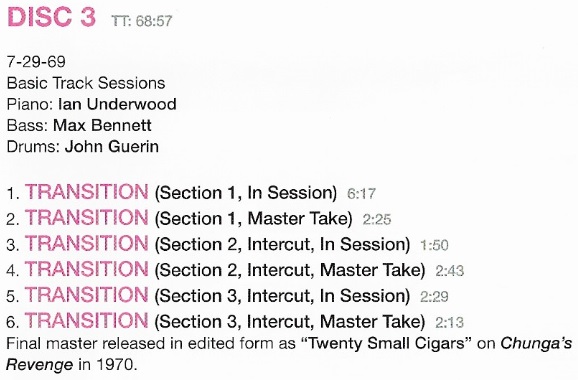
The 2019 ZFT release "The Hot rats sessions" includes the recording session for the basic tracks of "Twenty small cigars",
at that moment having the working title "Transition", the recording date being July 29th '69. The next day Zappa overdubbed his guitar
and harpsichord parts.
4. The Nancy and Mary music
This is a live recording from 1970. Touring with his newly formed band commenced in June, 1970, but most recordings with this band stem from 1971. The next section
from this study deals with the few live recordings from 1970 that existed before 2016. There's a large number of live recording available by now, with the ZFT filling in many gaps (see the YCDTOSA
section for an overview of live compilations). The 1970 gap was filled in in 2016 with "Road tapes, venue #3",
with the two concerts at the
Tyrone Guthrie theater in Minneapolis (July, 1970). The "Nancy and Mary music" is a larger collage
of solos from two pieces, as played during these gigs. It contains two guitar solos by Zappa himself, in Eb en D Dorian.
The correspondences are:
The Nancy and Mary music:
- 0:00-1:40 = 8:11-9:51 from Road tapes #3, disc I, track 12.
- 1:40-2:41 = 7:20-8:20 from disc II, track 12.
- 2:42-5:44 = 10:07-13:08 from disc I, track 12.
- 5:45-9:27 = 15:17-18:59 from idem.
The Nancy and Mary music, 4:09 till 4:33 (midi file).
The Nancy and Mary music, 4:09 till 4:33 (transcription).
This example contains most of the joint sax and guitar improvisation, that starts at 4:00. At bar 11 the sax stops and the guitar
continues with a solo. The bass is playing around an Eb pedal during bars 1-10. Next the bass continues with a one-bar-vamp during the beginning of the solo.
The example from above corresponds with 11:33-11:57 minutes from Road tapes #3, track I.12. The emphasis in these bars lies upon playing around Eb at first,
followed by ticking the Ab as 16th notes. From bar 15 the solo continues in a standard manner.
Overview of the two pieces these sections are taken from:
Road tapes #3, disc I, track 12: King Kong/Igor's boogie:
- 0:00 Theme two from the live performances of "King Kong" (see the Uncle Meat section of this study at "Uncle Rhebus").
- 0:24 Igor's boogie, phase one (see the Burnt weeny sandwich section).
- 1:38 Little guitar theme in Eb Dorian, as introduction for the solos.
Road tapes #3, I.12, 2:00 till 2:19 (midi file).
Road tapes #3, I.12, 2:00 till 2:19 (transcription).
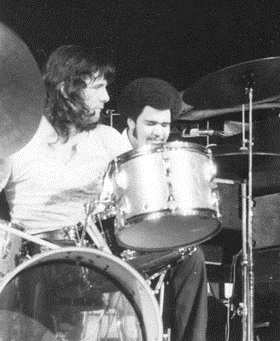 This guitar theme is a sequence of four bars in 4/4 in Eb Dorian. It gets repeated twice, the second time transposed up
a fourth from Eb to Ab as starting point. This is where the transcription from above begins. Bars 1-4 are the second repetition
of the sequence. Bars 5-7 contain the opening of the seguing guitar solo. As it comes to compositions, the new Mothers started
where the earlier Mothers had stopped. The sound of the band on "Road tapes #3", however, goes pretty differently. It's denser with George Duke on keyboards and especially Aynsley Dunbar on drums (photo to the right). Zappa described him as sounding like two drummers.
Even so things would change again soon when the groupie opera got constructed during the 1970 fall tour. So, as more
often in Zappa's career, "Chunga's revenge" and "Road tapes #3" are in their character and sound specific of only one year
of recording and touring.
This guitar theme is a sequence of four bars in 4/4 in Eb Dorian. It gets repeated twice, the second time transposed up
a fourth from Eb to Ab as starting point. This is where the transcription from above begins. Bars 1-4 are the second repetition
of the sequence. Bars 5-7 contain the opening of the seguing guitar solo. As it comes to compositions, the new Mothers started
where the earlier Mothers had stopped. The sound of the band on "Road tapes #3", however, goes pretty differently. It's denser with George Duke on keyboards and especially Aynsley Dunbar on drums (photo to the right). Zappa described him as sounding like two drummers.
Even so things would change again soon when the groupie opera got constructed during the 1970 fall tour. So, as more
often in Zappa's career, "Chunga's revenge" and "Road tapes #3" are in their character and sound specific of only one year
of recording and touring.
- 2:12 1st Guitar solo.
- 5:08 1st Sax solo.
- 7:40 Little interlude.
- 8:12 2nd Sax solo.
- 8:48 Drum solo.
- 10:24 Extravaganza by the band and audience participation.
- 11:24 Joint improvisation by the sax and guitar.
- 11:50 2nd Guitar solo in Eb Dorian.
- 13:09 Guitar chord progression, followed by a keyboard solo.
- 17:21 More extravaganza by the band and audience participation.
- 20:25 End.
Road tapes #3, disc II, track 12: The clap (Chunga's revenge):
- 0:00 Theme from Chunga's revenge (see below at track 7).
- 1:30 Keyboard solo.
- 3:28 Sax solo.
- 7:20 Guitar solo.
- 11:12 Reprise of the theme.
- 12:17 Applause with the "Mondellos" thanking the audience.
- 13:01 End.
It's all "Chunga's revenge" during the latter track and not "The clap" as
on the album, but possibly this was the original working title.
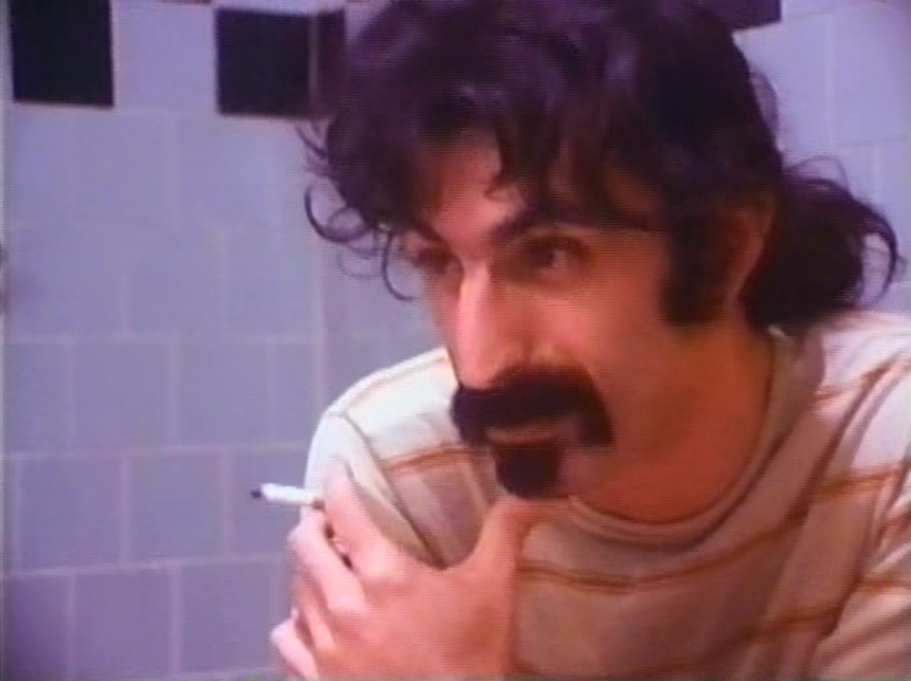

Two stills from the Uncle Meat movie, 1970 takes. Left: Zappa telling of his problem of
how to shoot continuity shots when he couldn't get hold of the original Mothers with only a week of filming time. It got solved in a way by
improvising things on the spot, like the scene at the right, with Phillis Altenhaus and Aynsley Dunbar at a supermarket near Zappa's house.
5. Tell me you love me (1970)
"Tell me you love me" begins with a catching guitar riff in F sharp Dorian/Mixolydian (the Dorian A natural and Mixolydian A# are used next to each other). By itself, I think, it has some "hit potential", but maybe Zappa
is using too many themes and variations in "Tell me you love me" to turn this song into a hit.
Tell me you love me (1970), opening (midi file).
Tell me you love me (1970), opening (transcription).
Transcribed above is theme A. The structure of the total song goes as:
0:00 Theme A.
0:21 Side theme 1 ("I love you so hard now").
0:24 Side theme 2 ("Don't make me lose my pride").
0:30 Side theme 3 ("Grab a hold of you").
0:37 Theme A, variation 1.
0:53 Side theme 1 ("I want to feel it").
0:57 Side theme 2 ("Don't make me steal it").
1:03 Theme B.
1:16 Theme A.
1:37 Side theme 1 ("I love you so hard now").
1:40 Side theme 2 ("Burning with fire").
1:46 Side theme 3 ("Cause I gotta make love").
1:59 Instrumental outro, first played as intermezzo.
2:11 Theme A, variation 2.
2:23 Instrumental outro as final.
2:33 End
"Tell me you love me" (1980) returns on the later Tinsel town rebellion album
with the same structure, but harmonized quite differently. See the correspoding section of the example above in the shape of this version from 1980.
In 1988 it re-appeared as "Why don't you like me?" on the "Broadway the hard way" album
with the lyrics being newly written, next to varying musical material and citing from Michael Jackson's "Billy Jean" song. See the "Broadway the hard way
section for two examples taken from that CD.
6. Would you go all the way?
 All five songs with lyrics on "Chunga's revenge" can be called regular pop-songs. "Road ladies" is blues-like, "Tell me you love me" is rock 'n roll for its central lick.
The other three on the album - "Would you go all the way?", "Rudy wants to buy yez a drink" and "Sharleena" -
(also) belong to mainstream pop. "Sharleena" could be called a ballad as well. As it comes to their lyrics, all tracks on "Changa's revenge" are for Zappa standards mild. The same goes for "Tears began to fall"
on the next "Fillmore East" album, while everything else on that album goes into different directions.
To the right an outtake from page 18 of the score for "The restaurant scene" from "200 Motels", showing that Zappa originally planned to let this
title segue into "Would you go all the way?". It got replaced by "Mystery roach".
All five songs with lyrics on "Chunga's revenge" can be called regular pop-songs. "Road ladies" is blues-like, "Tell me you love me" is rock 'n roll for its central lick.
The other three on the album - "Would you go all the way?", "Rudy wants to buy yez a drink" and "Sharleena" -
(also) belong to mainstream pop. "Sharleena" could be called a ballad as well. As it comes to their lyrics, all tracks on "Changa's revenge" are for Zappa standards mild. The same goes for "Tears began to fall"
on the next "Fillmore East" album, while everything else on that album goes into different directions.
To the right an outtake from page 18 of the score for "The restaurant scene" from "200 Motels", showing that Zappa originally planned to let this
title segue into "Would you go all the way?". It got replaced by "Mystery roach".
Would you go all the way?, 1:56-2:23 (midi file).
Would you go all the way?, 1:56-2:23 (transcription).
"Would you go all the way?" begins with a series of smaller themes, before ultimately, at 1:22, the main theme gets introduced.
The example above is the outro of this song with variations upon this main theme.
- Bars 1-2: the main theme in F, sung over, basically, the I chord. Keyboards are playing freely in the background, with the transcription
only being an indication of what they're doing.
- Bars 3-4: the main theme, sung over the V chord.
- Bars 5-6: the main theme once more with the I chord.
- Bars 7-10: a sequence with only the first motif of the main theme. It gets sung over a series of major triads: G, Bb, C and D.
- Bars 11-13: final chord progression with G-F-Eb-Db-C, another series of major triads. Bars 7-13 can't be attributed to specific keys.
With the final C chord, on the other hand, this piece returns to the tonic it started with.
7. Chunga's revenge (1970)
 The bass riff from "Chunga's revenge" was used for soloing during jam sessions
with the new band in the studio. The album has Ian Underwood on distorted electric alto sax and
Zappa on guitar. One of the recordings was used for experimenting with four track
surround audio, today much used in cinemas. Several other of such mixes were done in the seventies and the
Zappa Family Trust (Dweezil in this case) released them as the "Quaudiophiliac" DVD
of 2004. The "Chunga basement" version of "Chunga's revenge" from "Quaudiophiliac"
is included in the next section.
Zappa referred to this technique with his line from "Camarillo Brillo": "she said
her stereo was four way". The relatively short theme from "Chunga's revenge" was used in the eighties
for introducing a longer guitar solo as present on "Buffalo" and "Trance-Fusion". See the latter section for
"Chunga's revenge (1988)".
The bass riff from "Chunga's revenge" was used for soloing during jam sessions
with the new band in the studio. The album has Ian Underwood on distorted electric alto sax and
Zappa on guitar. One of the recordings was used for experimenting with four track
surround audio, today much used in cinemas. Several other of such mixes were done in the seventies and the
Zappa Family Trust (Dweezil in this case) released them as the "Quaudiophiliac" DVD
of 2004. The "Chunga basement" version of "Chunga's revenge" from "Quaudiophiliac"
is included in the next section.
Zappa referred to this technique with his line from "Camarillo Brillo": "she said
her stereo was four way". The relatively short theme from "Chunga's revenge" was used in the eighties
for introducing a longer guitar solo as present on "Buffalo" and "Trance-Fusion". See the latter section for
"Chunga's revenge (1988)".
Chunga's revenge, theme (midi file).
Chunga's revenge, theme (transcription).
With D being the lower opening note of both
bar 1 and the riff, plus the central note of the main theme, the key is D Dorian. Bar 1 does the progression I-I-IV. Bar 5 incidentally begins with an F, bar 6
continues with the bass lick as it keeps being repeated. In bars 9-10 Zappa shortly lets some altered notes come passing by. In rock
terms the progression here is Asus4-Dm-Asus4-Ab. It's followed by two bars stressing just the G. Next the riff returns and
the soloing can start. To the left part of the Zappa photos by John Williams for the backside CD cover.
The "Chunga's revenge" title track got recorded during the March 1970 sessions at the Record Plant. The 2023 ZFT release "Funky nothingness"
includes two takes of this composition, lasting around 16 and 19 minutes, thus with much more improvisations as on the album.
The album version is largely an edited version of sections from these two takes.
8. The clap
Zappa as a multi-instrumentalist comes out the best on "Zoot allures" from 1976, playing guitar, bass and keyboard. On "Twenty small cigars" he's playing the melody of this piece on harpsichord, next
to the piano part by Ian Underwood. Zappa started his musical career as a drummer, but recordings with him
sitting behind a standard drum-kit are rare. Only some of the tracks from the Cucamonga period feature him as a drummer. Here he's using a large number
of percussion instruments, next to the regular drum set. Playing percussion is something he occasionally did. Like the duet with Jimmy Carl Black on "YCDTOSA vol. V" or the "Roxy, the movie"
DVD from 2015, where you can see him playing along with Ruth Underwood.
The clap, 0:11-0:22 (midi file).
The clap, 0:11-0:22 (transcription).
The example above is an outtake of 9 bars from "The clap", where you can hear three percussion sections playing together.
Since Zappa is credited for all parts, he must have overdubbed two percussion parts over his drum part.
This drum part is in steady 4/4 and must be the basic track. The woodblocks and tom-toms have tuned pitches, for which reason I'm using regular notation instead of crotches. Both are freely improvised. As far as you can say such terms are applicable in a situation like this,
it's atonal with bars 1-5 containing counterpoint melodies. More details about "The clap" came to the open with the ZFT release "Funky nothingness", showing
that the album version is only a small part of the total that got recorded.
Zappa's interest in drumming and percussion took a new turn when he obtained the synclavier, where he had to type in drum parts himself again. His final work,
"Dance me this", contains a number of passages from what he himself called "The rhythmic sadist's guide to drum patterns for the 21th century". It's a
fascinating world, difficult to come to terms with. Several examples from this CD can be found at the end of this study, though only a snippet of this synclavier percussion composition.
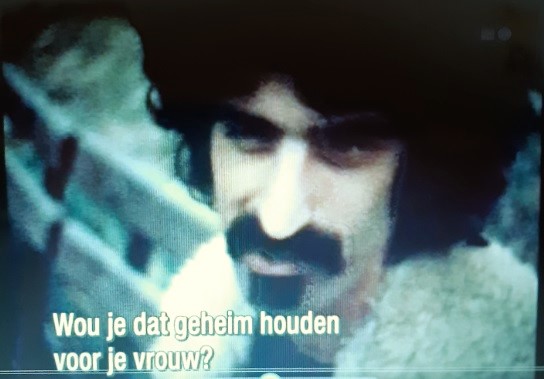
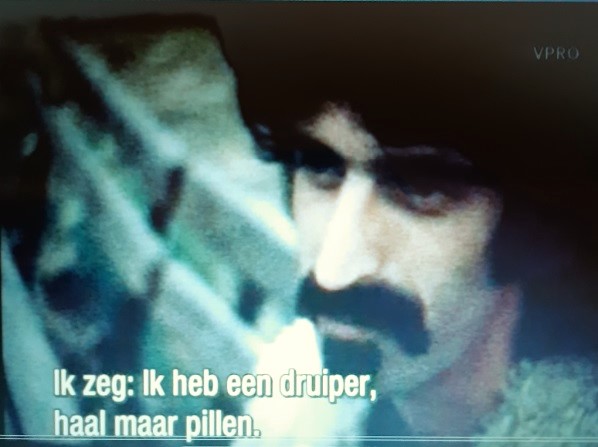
Two stills from the 1971 Zappa documentary by Roelof Kiers for VPRO television. In it Zappa talked about groupies and having sex on the road, the road ladies from track 2, with the occasional side effect
of getting venereal diseases. The title of track 8, "The clap", can be taken literal for its percussion beats. Very likely Zappa used it for its double meaning for it's also a vulgar
expression for gonorrhoea. In the printscreens he refers to it as the clap, translated with the corresponding Dutch vulgar expression "druiper". He explains that he couldn't possibly
keep it a secret from his wife what happened, and ask her to get a prescription.
9. Rudy wants to buy yez a drink
"Rudy wants to buy yez a drink" is a three-theme popsong with an instrumental interlude in it as bridge. Specifically this interlude has some
vaudeville elements in it. The song was played live during the 1976 tour as included on the ZFT "Philly '76" double CD. Next are sections from
both albums.
"Rudy wants to buy yez a drink", Chunga's revenge version (1970):
- 0:00 Instrumental opening progression in C, played twice: C-Am-Dm7-G. The transcription below starts with the repetition of this progression.
- 0:08 Theme I. The bass now changes the D from the previous progression to F, thus becoming C-A-F-G. The theme is sung twice, first
as a single melody (bars 3-7), next with Flo and Eddie singing in parallels (bars 8-11). The first example below ends here.
- 0:30 Coda of theme I with the chords G-F-G-F-G, thus like ending in G Mixolydian. The rhythm goes a bit syncopic.
- 0:36 Theme II. The meter now changes to 12/8 in swing time (with no tempo change of a meter, thus a dotted quarter note being equal
to a quarter note in the previous bar). This second theme is sung over a I-V alternation in F Lydian (or IV-I in C if you still want to interpret it
as belonging to the central scale).
- 0:51 Theme III. This theme can be seen as a variation upon theme I, in C again, sung over the same bass line notes.
- 1:16 Instrumental interlude in C as presented in the second transcription below, played with some rubato. Its basis is a I-II alternation.
- 1:35 Theme I. The bass once plays C-A-D-G as at the beginning of the song and next returns to C-A-F-G.
- 1:56 Theme I once more.
- 2:11 Sung coda over the bass line G-F-E-D ("Now I go away.").
- 2:20 Closing chords with Zappa mingling C and A minor. The progression is C-G-C, followed by G#m7-5 - Am7. Thus its tail is VII-I in A minor
with the major 7th (G#).
- 2:44 End.
Rudy wants to buy yez a drink (1970), opening (midi file).
Rudy wants to buy yez a drink (1970), interlude (midi file).
Rudy wants to buy yez a drink (1970), opening (transcription).
Rudy wants to buy yez a drink (1970), interlude (transcription).
"Rudy wants to buy yez a drink", Philly '76 version:
- 0:00 Instrumental opening progression with just the bass line from above with drum beats, C-A-D-G.
- 0:08 Theme I. Other than in 1970 the bass doesn't change the D to F, the progression remains C-A-D-G throughout the song. Zappa first sings theme I alone.
The bass is playing its notes in the manner of bar 1 in the transcription below with off-beat drumming.
- 0:23 Coda of theme I as described above (bars 3-4).
- 0:26 Theme IV. The meter now changes to 12/8 in swing time as above, but the sung theme goes quite different (bars 4-8). The transcription below contains the G Mixolydian
tail from theme I, followed by a I-V alternation in F Lydian as in theme II as described above for the 1970 version.
This is the section that seriously deviates from the 1970 version. In the other parts it's more the details that differ. The remainder of this version goes similar
to my description of the 1970 version.
Rudy wants to buy yez a drink (1976), section (midi file).
Rudy wants to buy yez a drink (1976), opening (transcription).
- 0:40 Theme III.
- 1:00 Instrumental interlude.
- 1:16 Theme I.
- 1:40 Theme I once more with Bianca Odin and Ray White now singing along with Zappa.
- 1:53 Sung coda.
- 2:12 Closing chords.
- 2:20 End.
10. Sharleena (1970)
The following example is another mainstream piece, the ballad "Sharleena" in G Minor (bars 1-4) and Mixolydian (most other
bars of the transcribed part). It first appeared on "Chunga's revenge" and was recorded
again for "Them or us", where Zappa's son Dweezil contributed with a guitar solo.
"Playground psychotics" shows how this band could play "Sharleena (1971)" live
in a much higher tempo and with a different coda. See the Playground psychotics section for part of this end.
Sharleena, melody sections (midi file).
Sharleena, melody sections (transcription).
Transcribed here is the "Chunga's revenge" version. The opening theme moves over a downward going bass progression,
the chords formed being subsequently Gm, F, Ebmaj7, Am7-5, Dm7 and G. The second transcribed theme below
is made up of syncopic bars over a G pedal. "Sharleena" and "Tell me you love me" indicate the various ways Flo and
Eddie can sing in parallels in Zappa's songs. You can see thirds, fourths, sixths and larger intervals
going over an octave as a tenth in bar 5 of "Tell me you love me". Fifths turn up in the "Call any vegetable" transcription
from the Just another band from L.A. section. In "Latex solar beef" (Fillmore East section) they are sometimes alternating
each other, sometimes singing unisono. In the atonal part of "Billy the mountain" in this study they follow their own way.
So the overall picture you get is that Zappa liked to employ the duet as really two singers.
"Sharleena" got recorded first during the March 1970 sessions at the Record Plant with Don Harris doing the vocal part.
The ZFT triple CD "Funky nothingness" contains two versions stemming from these recordings, that Zappa himself released
on "The lost episodes", after some further editing.
